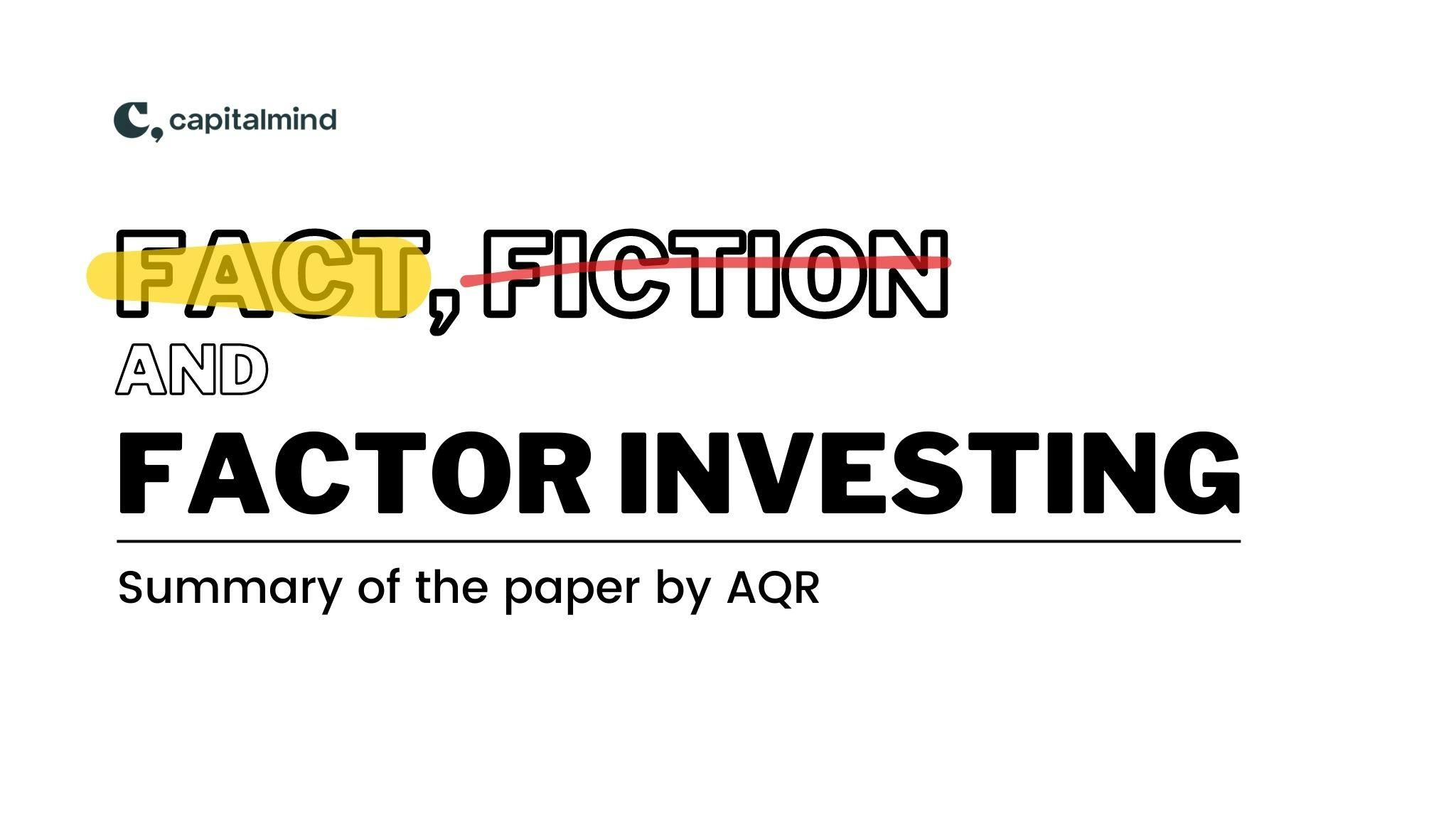(category)Foundations
How to think about Asset Allocation in India - Part 1How to think about Asset Allocation in India - Part 1
Getting usual Asset allocation advice is like listening to in-flight safety demonstrations. The airline crew has to give it, and you don't even have to pretend to listen. That's because the way we think and talk about Asset Allocation is broken. Asset Allocation is NOT about settling for lower return if you don't want to deal with volatility.
Anoop Vijaykumar•

Getting usual Asset allocation advice is like listening to in-flight safety demonstrations. The airline crew has to go through the motions, and you don't even have to pretend to listen.
That's because the way we think and talk about Asset Allocation is broken. Asset Allocation is NOT about settling for lower return in exchange for lower volatility.
In Part 1 of this two-part post, we examine the evidence how an actual and implementable asset allocation strategy outperforms an equity-only strategy.
In Part 2 we look at a few allocation scenarios, take a stab at what we think works best for most investors, and what next after Asset Allocation?
I went looking for the definitive and actionable piece on Asset Allocation for Indian Investors. Something to link to in our Getting Started guide for Capitalmind Premium subscribers.
Searching for "Asset Allocation India" turns up 4.4 Million results. This moneycontrol gem is the top result. Two slider-based questions to help you decide where to allocate your net worth.

It recommends 5% allocation to Real Estate if you have "Low" Risk Capacity and "Extremely High" Risk Tolerance. Only thing is you probably need ₹ 20 Crores net worth to get to that.
Looking for "primer on asset allocation" turned up a familiar Indian site. Except, the content looked a little too familiar.

On the right, screengrab of investor.gov, a US Securities and Exchange Commission website. On the left, the Indian site.
That's when you know no one is really even trying. It's not surprising.
Getting usual Asset allocation advice is like listening to in-flight safety demonstrations. "Sure, Thanks for telling me what to do with the two metallic ends of the buckle!". The small voice in your head that briefly suggests it'll be handy to know the location of the closest emergency exit gets silenced by "what if something life-changing turns up on my twitter feed as we taxi for takeoff?".
[bctt tweet="Getting usual Asset allocation advice is like listening to in-flight safety demonstrations. The airline crew has to go through the motions, and you don't even have to pretend to listen. " username="capitalmind_in"]
The way we think and talk about Asset Allocation is broken. In two ways.
Personality Type as the start and end point
The sum total of Asset Allocation advice boils down to some version of a table with the words "Conservative", "Moderate", "Aggressive", and columns of percentages next to asset classes. Heck we have it on our portfolios getting started page.
I get the challenge financial advisors have. We face it in our PMS client conversations every day. Ask an investor about their next purchase after a few months of a secular bull run and they will not think twice about buying unhedged Futures. That same investor after a 15% correction will look suspiciously at a liquid fund holding nothing but Government debt.
Labels like Conservative, Moderate, Aggressive are more temporary states of mind than permanent investor personalities.
[bctt tweet="Investor Labels like Conservative, Moderate, Aggressive are more temporary states of mind than permanent investor personalities. " username="capitalmind_in"]
You're thinking, "But what about the 55 year old taking early retirement? Surely she is a "Conservative" investor?" Not necessarily. For one, her age says nothing about her risk personality or what she wants to do over the next hopefully 30+ years.
One 55 year old might only want to continue living his comfortable lifestyle and leave an inheritance to his children. Another might want to visit the Amazon rainforest, see the Northern Lights, and maybe more. In the meantime, she is perfectly ok to live a minimalist lifestyle. Their asset allocation the day they retire should look very different.
And the bigger problem.
Too much theory, not enough evidence
30-70 Debt-Equity if you're young because 100 minus age into equities. You're conservative, so do 70-30. These things are considered as dogma. But who came up with these?
The asset-class percentages you see in asset allocation tables are supposed to have been derived from Modern Portfolio Theory and the concept of the Efficient Frontier.
Quick (I promise) summary of what's on the chart above.
Every asset has an "expected return" and associated variability around that return. So, Cash falls near the bottom left: Almost no risk of holding it but then also no return. i.e. You can be certain that Cash will consistently give you zero return year-after-year.
Like Cash, every asset can be plotted somewhere based on its historic performance. Stocks offer higher return with a lot more variability, so will be higher and much further to the right than Cash. Note that assets have been placed where I think they make sense.
The foundation of Asset Allocation is that combining different assets that do not move together gives you a portfolio that will offer higher return for lower risk (variability) compared to only holding any one asset.
And there is an ideal combination of assets for every risk-return combination. That "ideal" combination is the Efficient Frontier.
This means, if you are not on the efficient frontier, you are either taking too much risk to get your return, or conversely, getting too little return for the risk you are taking. In theory.
In theory, theory and practice are the same. In practice they are not.
Harry Markowitz's Efficient Frontier Model is elegant. But like any model, it relies on assumptions and data sanctity. For example, you could include Real Estate as an asset class and even ensure you have perfect data on prices and returns (yeah right). But the model does not know that there is still almost no liquid way to allocate to real estate in India. Certainly not for the average investor to take a 10-20% exposure.
[bctt tweet="Harry Markowitz's Efficient Frontier Model is elegant. But like any model, it relies on assumptions and data sanctity. " username="capitalmind_in"]
Most Indian investors already have sizeable parts of their net worth sitting in Provident Funds, i.e. Debt. Outside of those, until the Bharat Bond ETF, the only way for Indian investors to take exposure to a basket of debt instruments was through actively managed Debt Mutual Funds. Similarly, we could plug in Gold prices in the MPT Model but try to implement it and you'd struggle to find an instrument that would give you the real return of gold.
Such wrinkles make a big difference. We prefer to bias towards simpler strategies with known flaws over sophisticated but un-implementable ones.
Looking for evidence
The NIFTY+FD analysis was rudimentary but conveyed the importance of Asset Allocation. So we expanded the scope to include other assets: Gold and International Equities.
The questions we tried to answer:
- For an investor primarily in Indian equities, does adding other asset classes like Debt, Gold, and International Equities improve portfolio performance over regular Buy and Hold? (Performance includes annualised return as well as downside volatility)
- If asset allocation does improve portfolio performance, does it work better only some of the time, or most of the time? What proportion of each asset makes sense to maintain returns while reducing downside volatility or to improve overall returns?
- Finally, what should most investors do looking forward?
We'll address part of #2 and #3 in a separate post.
Rules for the backtest:
- Pick the most basic form of each asset class that allows us to go as far back as possible (remember Security Selection comes after Asset Allocation)
- Indian Equities: NIFTY TRI
- Debt: SBI 1 year Fixed Deposit Rate
- Gold: UTI Gold ETF
- International Equities: N100 ETF
- Rebalance annually on the first trading day of the year OR when a new asset class becomes available for the first time
Constraints:
- Our backtest goes back 30 years, to July 1990. The NIFTY TRI only started in June 1999. By comparing the difference in performance between the NIFTY and the NIFTY TRI, we reconstructed the TRI going back to July 1990. This ensures a fair comparison of NIFTY Buy & Hold versus Asset Allocation strategies
- We have prices for UTI Gold ETF going back to April 2007. So Gold does not figure in the portfolio until then even though we do have Gold prices for before then.
- The N100 ETF listed in March 2011. So in our analysis, International diversification was only possible starting 2011
To recap, From July 1990 to April 2007, the two assets available were the NIFTY and 1 year Fixed Deposits. From April 2007 to March 2011, Gold was added, and since March 2011, all four assets have been available.
The Simple Equal Allocation Strategy
Like the name suggests, this strategy splits the portfolio equally between available assets and Rebalances at the start of each year.
Chart shows the performance from July 1990 to June 2020 compared to the NIFTY Total Returns Index.

The NIFTY stays ahead of the Equal Allocation Strategy almost entirely through the 30 year timeline. But not by as much as you would expect given we were 50% allocated to Fixed Deposits for the first 17 years.
y-axis is on a log-scale, which means the chart shows percentage changes consistently. And that's why it's evident the Allocation Portfolio has a much steadier march from 100 to 5,010 compared to the NIFTY going from 100 to 5,598.
Chart below compares drawdowns in both portfolios.

As expected, a strategy that was always allocated to debt (Fixed Deposits) shows lower drawdowns than the NIFTY.
If you have felt the pain of sharp drawdowns of the past (and present), then just this chart should make you consider the impact of asset allocation.
The first chart does a poor job of showing what happened to performance since the additional assets, Gold and Nasdaq100 ETF were added to the mix.
Let's break it down by timeframe to see relative performance.
July 1990 to Apr 2007, we were allocating 50% to the NIFTY, and the other half into SBI 1 year Fixed Deposits.

Yet, it managed 14.1% / year (see chart below for what rates looked like back in the 90s), with less than half the volatility of the NIFTY and a maximum drawdown of 32% compared to 53%

Things get more interesting when you add other assets to the mix. From Apr '07 to Apr '11 we allocated equally to the NIFTY, FDs and Gold

And finally the N100 ETF launched in Apr 2011 to enable exposure to international equities.

Table below is the most important takeaway from this post. It summarises portfolio performance (return, volatility, maximum drawdown) in each "phase" of the backtest and overall.

An Equal Allocation portfolio is marginally behind the NIFTY-only strategy over 30 years, at less than half the volatility, and lower drawdowns.
Notice how since 2007, the Equal Allocation strategy has outperformed the NIFTY-only strategy comfortably, with lower downside volatility.
Table below shows returns by calendar year.
The Equal Allocation strategy outperforms in only 13 out of the 31 years but by avoiding the worst years, it delivers comparable returns at lower volatility. Notice how the allocation strategy does in down years.
[bctt tweet="An Equal Allocation strategy outperforms in only 13 out of the 31 years but by avoiding the worst years, it delivers comparable returns at lower volatility. " username="capitalmind_in"]
More recently however, the allocation portfolio outperforms the NIFTY comfortably.

A simple equal-weight allocation to assets that are available outperforms the NIFTY all the way back over a 15 year time frame.
Bottomline
US investors have it easy. Get all the diversification you need by buying just 3 ETFs: VTI (US Stocks), VXUS (International Stocks), BNDW (World Bonds). Of course, specialise from there to get more specific (e.g we would replace VTI with QQQ). Indian investors have had few opportunities to diversify effectively.
Asset Allocation works. Not just to protect downside but in delivering better returns as well.
Once we have a broader mix of assets, even the returns start looking better. The last 9 years are not even a contest. An Indian Equities + FD + Gold + US Equities portfolio outperforms an Indian equities only portfolio by a distance.
Of course, this does not mean the next 9 years will be the same. But that's the point of asset allocation. It is a regret-minimisation framework that ensures you are not concentrated in the best or the worst-performing asset.
So far, notice how we did not optimize for allocation percentages that give us the best backward looking return? But is equal-allocation realistic?
50-50 NIFTY-FD might seem a little too defensive. At the same time, giving Gold and international equities the same weight as Indian equities appears unrealistic.
Read Part 2 where we look at outcomes from different allocation strategies and talk about our recommendation here. (You can sign up for the free trial to access this premium post)
Do you first think "which stocks or mutual funds" and then about asset allocation? Let us know @capitalmind_in. Subscribe to Premium to get full access to all our research and portfolios. Use Coupon Code CMPOFF10 to get 10% off regular price on the Annual Plan.
Related Posts
Make your money work as hard as you do.
Talk to a Capitalmind Client AdvisorInvesting is not one size fits all
Learn more about our distinct investment strategies and how they fit into your portfolio.
Learn more about our portfoliosUnlock your wealth potential
Start your journey today




